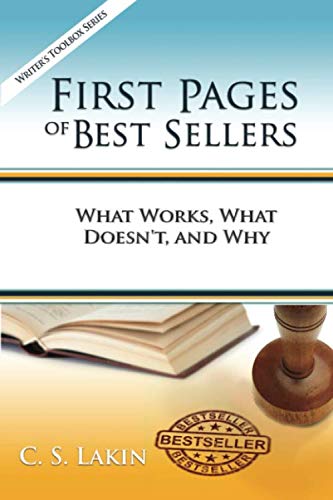


Full description not available
S**R
Solid and helpful, but not Lakin's best
As usual, C. S. Lakin gets right to the point, and illustrates her points with numerous examples and commentary that helped me see exactly how to apply her principles. Though her advice is always valuable, I found this book less engaging and involving than her others (Shoot Your Novel, for example). This was in part due to the highly analytical "checklist" approach she used to frame the analysis of each first page; this unvaried style got a little tedious after 20 first pages. But more critically, I was left with several questions. For example, one of her checklist points is that it is important to establish the voice and personality of the main character on the first page, and an important method for doing this is dialog. Yet approximately three quarters of her first page samples did not include dialog. Further, she didn't count internal monologue, or a first person narrator addressing the reader directly (which most of her examples DID have. Approx 10 pages from the end, she quickly mentions this dialog issue, but never really goes back and shows us how those "non-dialog" techniques work.
C**.
Highly recommend
I don’t often read craft books front to back, but this one is an exception. I’m revising my first chapter and CS Lankin’s First Pages of Best Sellers came at exactly the right time for me. I love the format: after 16 pages discussing specific elements crucial to engaging (seducing is the word I think of) readers on the first page, Lankin then presents about 24 first page examples of best sellers (think Steven King, Sue Monk Kidd, Paula Hawkins, Andy Weir) and dissects what works and what doesn’t. I don’t agree with all of her assessments, but we all have different tastes in what we enjoy. However having finished this craft book, I feel better equipped to assess my own opening. In fact, I’mDownright excited to get started.
H**.
It's an okay book
For some reason, it wasn't what I expected about first lines. Also, I have never yet read a book by Ms. Lakin that did not need numerous edits, which I find disappointing since she labels herself an editor. She does have good content in all of her non-fiction books, which I why I read them. But she seriously needs someone to edit her own work. One of the books by her and fellow editors (it was something "fatal flaws") was so badly riddled with errors I was embarrassed for her and the others. I'm not through reading this book, but already there are 27 edit errors.
M**E
Great used book and Lakin's does a Great job
This book offers writers what works-and doesn't in the first few pages of your novel. Many examples are shared...Lakin uses easy to follow do's and don'ts.Great used book-- like new condition.
M**S
Extremely Helpful
This book immediately moved into concrete examples. No wandering around in irrelevant details that sometimes span chapters. Critiquing mostly high quality writing was very effective, especially with the consistent format of the checklist. About half way through I started picking up on some of what her analysis found. It's caused me to see my own writing with fresh eyes. Highly recommend.
K**R
Let's go!
This book is very informative on starting your novel. You are given detailed advice on how and what you must accomplish to book your reader and hold on to them. This is a wonderful tools to use. Thanks!
R**K
Great Advice with Examples
I love this book. It has helped me craft better starts for my novels and short stories.
D**D
C.S. Lakin is a great writing coach.
In the area of teaching writing craft, she hasn't written a bad one yet! Congratulations, Susanne!
L**Z
A Useful Addition to the Writer's Library
I didn't always agree with her views e.g. on All The Light We Cannot See, but there is enough useful information in this book, and the examples of first pages which she cites, are sufficiently broad to inspire a writer to try different techniques. 4 stars for this book and 5 stars for the resources on her website, which include her all-encompassing First-Page Checklist.
A**L
Good for aspiring authors
Reading how the pros do it is always helpful, but for a book about writing, it suffers from more typos than I would expect from an author of this calibre.
TrustPilot
2 周前
1 个月前